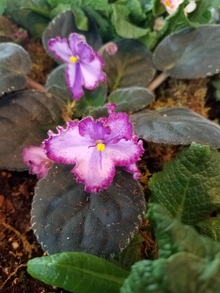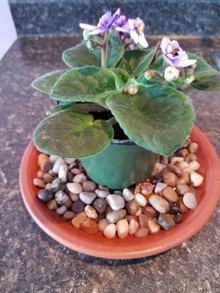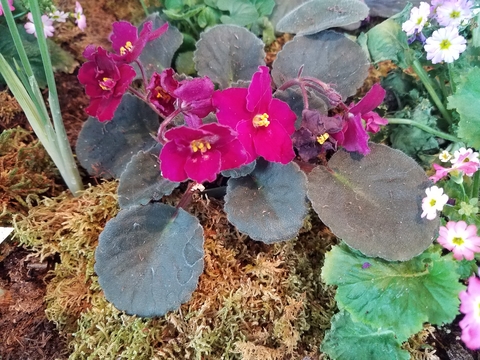Quick facts
African violets (Saintpaulia ionantha) are low maintenance, easy to grow houseplants. They reliably bloom several times a year when cared for properly.
Native to Eastern Africa, these popular houseplants are in the same family (Gesneriaceae) as gloxinia and primrose.
Plant characteristics
- Size
- Miniature / semi-miniature - less than 8 inches wide
- Standard - 8 to 16 inches wide
- Large - more that 16 inches wide
- Plant form - round, mound, rosette
- Flower colors - white, pink, maroon, blue, lavender, violet, deep purple
- Flower shapes - single, semi-double, double, ruffled, star, wasp
- Leaf shape - Round, heart-shaped, oval; fuzzy, velvety texture
- Leaf color - Silvery-green, bright green, deep green; creamy white leaf edges
Growing African violets
- A bright, cool location is best for growing African violets.
- Windows that provide north, northwest or northeast exposures work well.
- Fluorescent or LED grow lights may also be used alone or to supplement natural light.
- Plants need 14-16 hours of light and 8-10 hours of darkness daily to flower.
If you are comfortable, your African violet is comfortable.
Optimal room temperature for growing African violets is between 60 and 80 F and ideally 70 F.
Humidity at 40-60% will help African violets thrive. Group plants together to conserve humidity or set plants on trays of pebbles and water.
Make sure the plant does not sit in the water, but just above it.
African violets have fine roots and require well-drained soilless potting mixes with a pH of about 6.2 - 6.5.
- Pre-mixed commercial blends high in peat are available at most retail garden centers.
- Some growers recommend a blend of 50% commercial African violet potting mix and 50% perlite.
- Planting containers should have one or more holes in the bottom that allow excess water to drain. Never allow the plant to sit in water.
- Re-pot plants in fresh potting mix once a year.
Do not use softened or chlorinated water for African violets. Use room-temperature distilled water, rain water or reverse-osmosis water. Keep the potting mix moist at all times, but not soggy, and never let your plant sit in water.
Root rot from over watering is one of the most common reasons African violets die.
Three ways to water African violets:
Water from the top
- Use a baster, syringe or bottle with a narrow spout
- Carefully water just the potting mix. Avoid getting water on the leaves as this can cause leaf spots. Gently brush or shake off any water droplets on leaves.
Water from the bottom
- Set the pot in a bowl of room-temperature water, 1-inch deep.
- When the soil surface feels moist, remove the plant from the bowl of water and allow excess water to drain from the pot.
- Self-watering pots are also available.
Wicking
A “wick,” which is a length of nylon or polyester string used to draw up water, can provide steady moisture to your African violet plant’s roots. A wick can be added when you repot a plant, as shown below.
1. Thread a length of wet string or yarn (nylon or polyester) through a bottom hole in your empty pot. Allow about 6” to hang out the bottom of the pot.
2. Fill the pot to the top with potting mix.
Make a hole in the mix and insert your African violet plant.
Gently push potting mix up to the plant crown.
3. Cut a hole into the cover of a plastic container of water and mild fertilizer (about ⅛ recommended strength) and feed the wick into a reservoir.
4. Set the pot above the reservoir in a bright window.
Replenish the water as needed and avoid letting the wick dry out.
Fertilizers formulated for African violets can be purchased at many garden centers or online.
If a plant is dry, always moisten the potting mix with plain water to prevent possible root burn before fertilizing.
African violets require a mild fertilizer each time they are watered. Add one-quarter of the recommended amount of fertilizer and water, allowing excess liquid to drain from the pot.
Flush plant monthly with plain water to remove any excess fertilizer build-up.
African violet problems
Dust, soil, or debris on leaves
Solution: Use a dry artist’s paint brush or soft cloth to gently brush off the debris.
Remove dead leaves and spent flowers with a tweezers or small pointed pruner.
Lack of flowers; leaves are long and narrow
Cause: Not enough light; temperature is too cool
Solutions:
- Increase amount of light by relocating plants to a brighter location or adding artificial light.
- Increase temperature in room to 70s during the day, and 65 to 70 degrees Fahrenheit at night.
Leaves are pale and appear bleached out
Cause: Too much light
Solution: Relocate plant to place with less intense light.
Plant is limp and wilted even when soil is moist
Cause: Over watering; poor drainage; root rot due to roots being wet constantly
Solutions:
- Repot plant in a container that drains well.
- Do not let plant sit in water.
- If roots are mushy, brown and slimy, the plant is not likely to survive due to loss of roots.
Leaf spots
Cause: Water left on the leaves
Solution: Water plant from the bottom (see “Watering” above) to avoid getting water on the plant leaves.
Pale leaves, lack of growth and flowers
Cause: Nutrient deficiency, not fertilized regularly
Solution: Start fertilizing plant regularly.
Tight plant centers, rusty-colored leaves
Cause: Over fertilization
Solutions:
-
Flush plant with plain water to wash out excess fertilizer.
-
Reduce fertilizer to every other watering.
Reviewed in 2024




